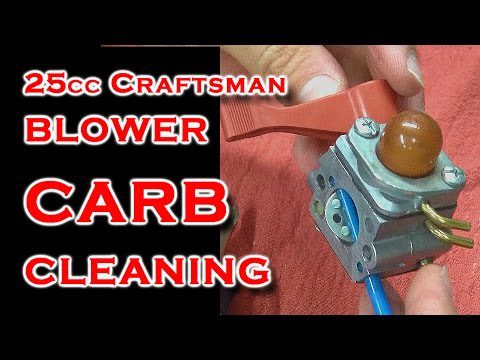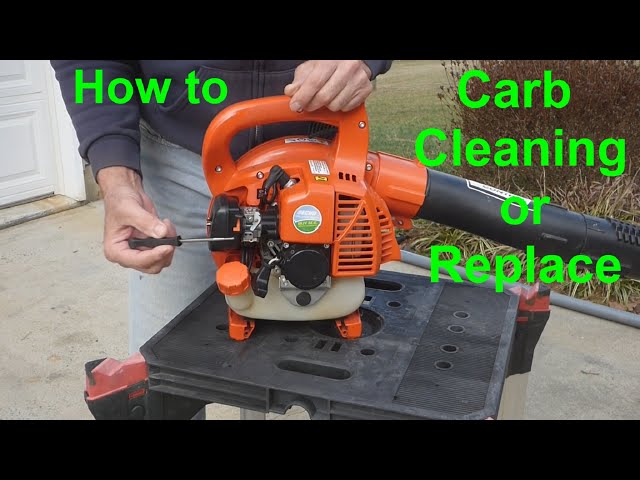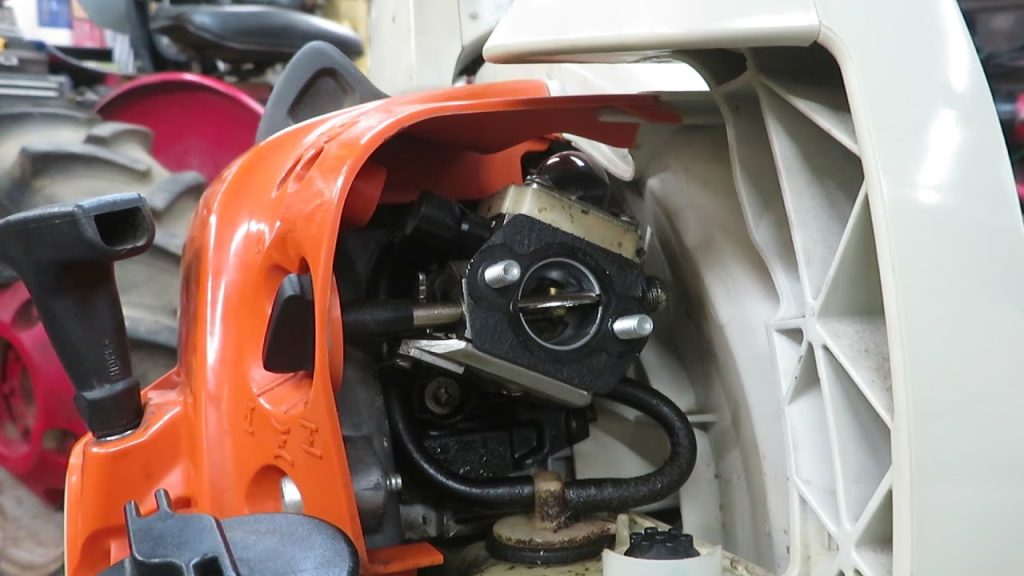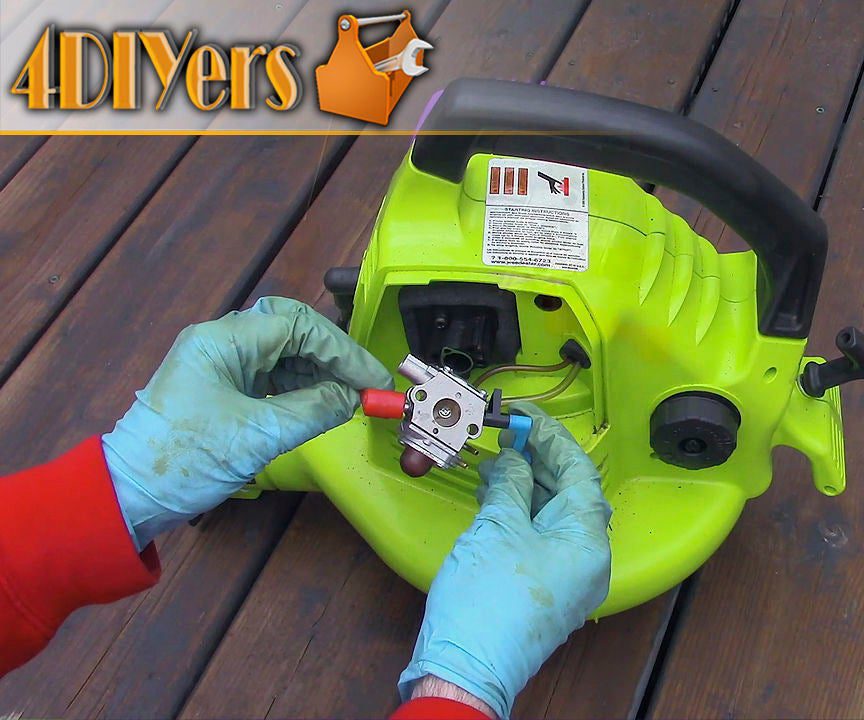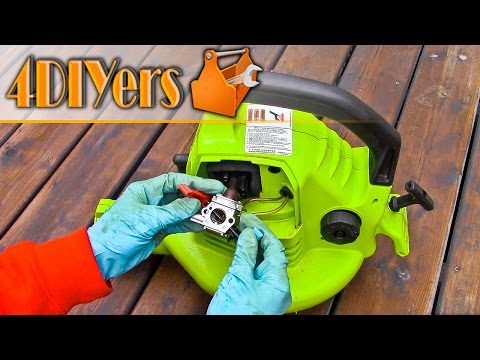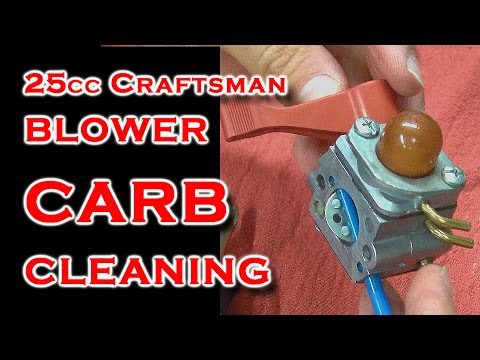Ever wondered how to tackle a clogged leaf blower carburetor? Look no further! In this article, we will guide you through the simple steps to get your leaf blower back in top shape. We understand the frustration of a clogged carburetor hindering your yard work, so we’re here to help. Discover the easy techniques and tools you need to clean your leaf blower carburetor effectively. Say goodbye to performance issues and hello to a smoothly operating tool. Let’s dive right into it!
Preparation
Gather Necessary Tools and Materials
Before cleaning a clogged leaf blower carburetor, it is important to gather all the necessary tools and materials. You will need a set of screwdrivers, including both flathead and Phillips head, a carburetor cleaner specifically designed for small engines, a clean rag, and a container to soak the carburetor in cleaner. Having all these tools and materials readily available will make the cleaning process more efficient and help ensure a successful outcome.
Ensure Safety Precautions
Safety should always be a top priority when working with any machinery or equipment. Before starting the cleaning process, it is crucial to take proper safety precautions. Make sure to wear safety goggles to protect your eyes from any debris that may fly during the disassembly process. Additionally, wearing gloves will protect your hands from any potential injuries. It is also important to perform the cleaning in a well-ventilated area to prevent inhaling any harmful fumes from the carburetor cleaner. By following these safety measures, you can work confidently and minimize any risks involved.
Locating the Carburetor
Identify the Carburetor’s Location
To begin the cleaning process, you first need to identify the location of the carburetor on your leaf blower. While the exact location can vary depending on the make and model of the leaf blower, the carburetor is typically found near the air filter. It is a small, metal component connected to the engine with fuel lines. Refer to the leaf blower’s manual or do an online search specific to your model to determine the precise location.
Access the Carburetor
Once you have located the carburetor, you need to access it for cleaning. Start by turning off the leaf blower and allowing it to cool down if it has been running. Then, using the appropriate screwdriver, remove the screws or bolts that secure the carburetor cover. Carefully lift off the cover to expose the carburetor. Take note of the position of any gaskets or seals for proper reassembly later. With the cover removed, the carburetor is now ready for disassembly and cleaning.
This image is property of i.ytimg.com.
Disassembly
Disconnect the Spark Plug
Before disassembling the carburetor, it is essential to disconnect the spark plug. This precautionary step ensures that the engine is completely shut off, preventing any accidental starting while working on the carburetor. Locate the spark plug wire, which is usually a black, rubber-coated wire connected to the spark plug. Gently pull on the boot or connector at the end of the wire to detach it from the spark plug. This step guarantees your safety and allows for a thorough cleaning process.
Remove the Air Filter
To access the carburetor fully, the air filter should be removed. The air filter prevents dirt and debris from entering the engine and carburetor. Removing it will provide clear access to clean the carburetor thoroughly. Depending on your leaf blower’s design, the air filter may be held in place by screws or clips. Use the appropriate tools to loosen and remove the fasteners, enabling you to take out the air filter. Inspect the filter for any signs of damage or excessive dirt accumulation to determine if it needs replacement.
Detach the Carburetor
With the spark plug disconnected and the air filter removed, it is time to detach the carburetor. The carburetor is typically held in place by screws, bolts, or clips. Carefully unscrew or unfasten the components securing the carburetor to the engine. Keep in mind that some carburetor models may also have fuel lines connected to them. Take note of the connections before removing the carburetor. Once detached, handle the carburetor with care to prevent any damage or unnecessary disassembly of its components.
Cleaning the Carburetor
Inspect the Carburetor for Debris
Before starting the cleaning process, visually inspect the carburetor for any signs of debris or blockages. Look for dirt, grime, or varnish buildup on the exterior surface. Check the inside of the carburetor for any clogs or obstructions in the ports and passageways. Identifying the extent of the blockage will help determine the intensity of cleaning required and whether any additional measures, such as soaking, may be necessary.
Spray Carburetor Cleaner
To effectively clean the carburetor, use a carburetor cleaner specifically designed for small engines. With the carburetor placed in a well-ventilated area, spray the cleaner onto all visible surfaces, including the exterior and interior components. Ensure that the cleaner reaches the ports and passageways within the carburetor. The carburetor cleaner will effectively dissolve any dirt, varnish, or other deposits, making it easier to remove during the cleaning process.
Clean the Ports and Passageways
After spraying the carburetor cleaner, it is time to clean the ports and passageways thoroughly. Use a thin, soft-bristle brush or a pipe cleaner to gently scrub away any remaining dirt or debris. Pay close attention to the small openings and crevices to ensure a comprehensive cleaning. Be careful not to use excessive force or abrasive materials that may damage the delicate components of the carburetor. Patience and a gentle touch are key when cleaning these intricate parts.
Soak the Carburetor in Cleaner
If the carburetor is heavily clogged or has stubborn deposits, soaking it in cleaner may be necessary. Fill a container with the appropriate amount of carburetor cleaner recommended by the product instructions. Submerge the carburetor in the cleaner, ensuring it is fully covered. Allow the carburetor to soak for the recommended time, usually around 10 to 15 minutes. This soaking process will help break down any tough buildup and facilitate its removal.
Remove Remaining Dirt and Residue
After the carburetor has soaked, carefully remove it from the cleaner and inspect it for any remaining dirt or residue. Use a clean rag or a soft-bristle brush to wipe away any loosened debris. Ensure that all ports and passageways are free from any clogs or obstructions. If necessary, repeat the spraying, brushing, and soaking steps until the carburetor is thoroughly cleaned. Take your time during this process to achieve optimal results.
This image is property of i.ytimg.com.
Reassembly
Dry the Carburetor
Before reassembling the leaf blower, it is crucial to ensure that the carburetor is completely dry. Any leftover moisture can lead to improper functioning or potential damage to the engine. Carefully wipe the carburetor with a clean, dry cloth to remove any excess liquid. Alternatively, you can use compressed air to blow out any remaining moisture from the ports and passageways. Give the carburetor enough time to air dry fully before proceeding with the reassembly.
Replace the Carburetor
Once the carburetor is dry, it is time to reattach it to the engine. Align the carburetor in its original position, making sure all gaskets and seals are correctly placed. Secure the carburetor with the screws, bolts, or clips that were removed earlier. Ensure that all connections are tight and secure, but be careful not to overtighten, as this can cause damage. Double-check that the carburetor is properly positioned and seated before moving on to the next step.
Reattach the Air Filter
With the carburetor back in place, it is important to reattach the air filter. Clean or replace the air filter if necessary before reinstallation. Align the air filter with its designated housing, ensuring that it fits securely. Fasten the screws or clips that hold the air filter in place, making sure it is properly sealed. A well-maintained and clean air filter is vital for the leaf blower’s optimal performance and longevity.
Connect the Spark Plug
The final step in the reassembly process is connecting the spark plug. Take the spark plug wire and carefully slide the boot or connector back onto the spark plug until it fits snugly. Ensure that there is a secure connection by giving it a gentle pull to confirm it is properly attached. With the spark plug connected, the leaf blower is now ready to be tested.
Testing
Inspect for Neat Assembly
Before starting the leaf blower, take a moment to inspect your work. Ensure that all screws, bolts, and clips are tightly secured. Check that all connections to the carburetor, air filter, and spark plug are properly aligned and fastened. A neat assembly will contribute to the leaf blower’s overall performance and reliability. Any loose or misaligned components should be immediately addressed before proceeding.
Start the Leaf Blower
To test the cleaned carburetor, start the leaf blower according to the manufacturer’s instructions. Prime the engine if necessary, and then pull the starter cord or engage the ignition button. Observe the engine’s initial startup and listen for any unusual sounds. A properly cleaned carburetor should allow the engine to start smoothly and accelerate without hesitation. If the leaf blower starts without issues, proceed to the final step. Otherwise, retrace your steps and check for any potential problems.
Check for Normal Functioning
Once the leaf blower is running, test its functionality by engaging the throttle and checking for a smooth and consistent response. Ensure that the engine idles properly without stalling or surging. Additionally, verify that the leaf blower produces a strong and consistent airflow. Watch out for any abnormalities, such as engine vibrations, unusual smells, or fuel leakage. If any issues persist, it may be necessary to troubleshoot further or seek professional help.
This image is property of content.instructables.com.
Troubleshooting
Inspect Fuel Lines
If the leaf blower continues to exhibit issues after cleaning the carburetor, inspect the fuel lines. Check for any cracks, leaks, or blockages in the fuel lines that may affect the fuel flow. Replace any damaged or deteriorated fuel lines to ensure proper fuel supply to the carburetor. It is crucial to address fuel line issues promptly to prevent further damage to the carburetor and engine.
Check the Fuel Filter
Another common culprit for leaf blower problems is a clogged or dirty fuel filter. A dirty fuel filter restricts fuel flow and can cause poor engine performance. Locate the fuel filter, which is typically located along the fuel line between the fuel tank and the carburetor. Remove the filter and inspect it for any signs of dirt or debris accumulation. If necessary, clean or replace the fuel filter to restore proper fuel flow and prevent future carburetor issues.
Examine the Spark Plug
A faulty or damaged spark plug can also lead to leaf blower performance issues. Carefully remove the spark plug and examine it for signs of wear, damage, or excessive carbon buildup. A worn-out spark plug may need replacement for optimal ignition and engine performance. Follow the manufacturer’s recommendations regarding spark plug gap and torque specifications. Installing a new spark plug can often solve problems related to starting difficulties, misfires, or lack of power.
Confirm Air Filter Cleanliness
After cleaning the carburetor and reassembling the leaf blower, double-check the air filter for cleanliness. A dirty or clogged air filter can disrupt airflow and lead to performance issues. Inspect the air filter for any dirt or debris accumulation and clean or replace it as necessary. Regularly maintaining a clean air filter will not only improve the leaf blower’s performance but also extend the lifespan of the carburetor and engine.
Maintenance Tips
Use Fresh Fuel
To keep your leaf blower and carburetor running smoothly, it is important to use fresh fuel. Stale or contaminated fuel can clog the carburetor and lead to poor engine performance. Always use high-quality fuel recommended by the manufacturer and avoid using stale or old fuel that has been stored for an extended period. Consider using a fuel stabilizer if you anticipate storing the leaf blower for an extended period to prevent fuel degradation.
Regularly Clean the Air Filter
Frequently cleaning the air filter is a vital part of maintaining a clog-free carburetor. Check the air filter regularly, especially before each use, and clean it if necessary. Remove any dirt or debris buildup that may obstruct airflow. Cleaning the air filter with compressed air or washing it with mild soap and water is typically sufficient. Ensure that the filter is completely dry before reinstalling it.
Properly Store the Leaf Blower
Proper storage of the leaf blower when not in use is crucial to prevent carburetor and engine issues. Store the leaf blower in a clean and dry area, preferably in a well-ventilated space. Avoid exposing the equipment to extreme temperatures or excessive moisture. Before storing, run the leaf blower briefly to burn off any remaining fuel in the carburetor, or use a fuel stabilizer to prevent fuel deterioration. Keep the carburetor and air filter covered to prevent dust or debris from entering during storage.
This image is property of i.ytimg.com.
Common Issues
Carburetor Blockage
One of the most common issues with leaf blowers is a clogged carburetor. Dirt, debris, and varnish can accumulate in the carburetor over time, obstructing proper fuel and air flow. This can result in starting difficulties, poor performance, and even engine stalling. Regular cleaning and maintenance of the carburetor can prevent blockages and ensure optimal leaf blower operation.
Fuel Supply Problems
Problems with the fuel supply can arise from issues with the fuel lines or a clogged fuel filter. Restricted fuel flow can cause poor engine performance, starting difficulties, or even engine damage. Regularly inspecting and maintaining the fuel system, including the fuel lines and filter, can help prevent these issues and keep your leaf blower running smoothly.
Dirty or Damaged Air Filter
A dirty or damaged air filter can impede airflow, leading to reduced performance and potential carburetor problems. The air filter plays a crucial role in preventing dirt and debris from entering the engine. Regularly cleaning or replacing the air filter will maintain its effectiveness and ensure proper carburetor function.
Spark Plug Issues
Faulty or worn-out spark plugs can cause starting problems, misfires, and reduced engine power. The spark plug is responsible for igniting the fuel mixture inside the engine cylinder. Regularly checking, cleaning, and replacing the spark plug when necessary will promote smooth starting and optimal engine performance.
When to Seek Professional Help
Persistent Carburetor Issues
If you have followed all the cleaning and maintenance steps outlined above, but the carburetor problems persist, it may be time to seek professional help. A certified technician with expertise in small engines will be able to diagnose and resolve any complex carburetor issues that may require specialized tools or knowledge.
Lack of Technical Knowledge
If you are inexperienced or lack technical knowledge in working with small engines, it is advisable to seek professional assistance. Mishandling or incorrectly assembling the carburetor can cause further damage or void warranty coverage. Professionals can ensure a proper and thorough cleaning, avoiding potential complications.
Complex Mechanical Problems
In some cases, carburetor issues may be a symptom of more complex mechanical problems within the leaf blower. Issues such as engine compression problems or ignition system malfunctions may require professional diagnosis and repair. If you suspect that the carburetor problems are related to broader mechanical issues, it is best to consult with a professional technician to accurately identify and address the underlying problem.
Cleaning a clogged leaf blower carburetor is an essential part of maintaining optimal performance and extending the lifespan of your equipment. With proper preparation, safety precautions, and thorough cleaning techniques, you can keep your leaf blower running smoothly and efficiently all season long. Regular maintenance, including fuel system inspections, air filter cleanliness, and proper storage, will reduce the likelihood of carburetor issues and ensure your leaf blower is always ready to tackle any outdoor task.
This image is property of i.ytimg.com.

